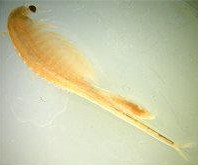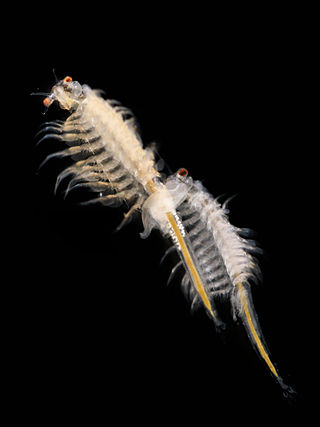
Branchiopoda is a class of crustaceans. It comprises fairy shrimp, clam shrimp, Diplostraca, Notostraca, the Devonian Lepidocaris and possibly the Cambrian Rehbachiella. They are mostly small, freshwater animals that feed on plankton and detritus.

Anostraca is one of the four orders of crustaceans in the class Branchiopoda; its members are referred to as fairy shrimp. They live in vernal pools and hypersaline lakes across the world, and they have even been found in deserts, ice-covered mountain lakes, and Antarctic ice. They are usually 6–25 mm (0.24–0.98 in) long. Most species have 20 body segments, bearing 11 pairs of leaf-like phyllopodia, and the body lacks a carapace. They swim "upside-down" and feed by filtering organic particles from the water or by scraping algae from surfaces, with the exception of Branchinecta gigas, or "giant fairy shrimp", which is itself a predator of other species of anostracans. They are an important food for many birds and fish, and some are cultured and harvested for use as fish food. There are 300 species spread across 8 families.

The conservancy fairy shrimp is an endangered small crustacean in the family Branchinectidae. It ranges in size from about 1.25 centimetres (0.49 in) to 2.5 centimetres (0.98 in) long. This species is endemic to California in the United States.

Branchinecta is a genus of fairy shrimp in family Branchinectidae. It includes around 50 species, found on all continents except Australia. Branchinecta gigas, the giant fairy shrimp, is the largest species in the order, with a length of up to 10 centimetres (4 in), and Branchinecta brushi lives at the highest altitude of any crustacean, at 5,930 metres (19,460 ft), a record it shares with the copepod Boeckella palustris. A new genus, Archaebranchinecta was established in 2011 for two species previously placed in Branchinecta.
Branchinecta longiantenna is a rare species of crustacean in the family Branchinectidae and the order Anostraca, the fairy shrimp. Its common name is longhorn fairy shrimp. It is endemic to California in the United States, where there are only four known populations. It is a federally listed endangered species of the United States.

Branchinecta sandiegonensis is a rare species of crustacean in the family Branchinectidae and the order Anostraca, the fairy shrimp. Commonly known as the San Diego fairy shrimp, it is named after the vernal pools found in San Diego County, California, where this species was originally discovered. It is also a federally listed endangered species of the United States.

Branchinella is a genus of crustaceans in the family Thamnocephalidae. This fairy shrimp genus is found across many parts of the world, but especially western Australia and southern Africa.

Branchinectidae is a family in the order Anostraca, containing two genera – Branchinecta and Archaebranchinecta. The majority of the species are in the genus Branchinecta, with only Archaebranchinecta pollicifera and the fossil Archaebranchinecta barstowensis in the second genus.

Artemia salina is a species of brine shrimp – aquatic crustaceans that are more closely related to Triops and cladocerans than to true shrimp. It belongs to a lineage that does not appear to have changed much in 100 million years.

Tanymastix stagnalis is a species of Anostraca that lives in temporary pools across Europe. It may reach up to 2 cm (0.8 in) in some areas and has 11 pairs of bristly, flattened appendages. It swims upside-down and filters food particles from the water. It is the only species of Anostraca in Ireland, having been discovered in Rahasane turlough in 1974.

Archaebranchinecta barstowensis is a species of fairy shrimp (Anostraca) that inhabited California during the Middle Miocene. Its fecal material is abundant in the concretions from the Barstow Formation. A limited number of whole specimens have been found, and they represent the "best-preserved fossil anostracan known to date". The closest relative of A. barstowensis appears to be Archaebranchinecta pollicifera from the surroundings of Lake Titicaca, and the two have been separated from the genus Branchinecta as the new genus Archaebranchinecta.
Branchinecta brushi is a species of fairy shrimp found at an altitude of 5,930 m (19,460 ft) in the Chilean Andes.
Branchinecta gaini is a species of fairy shrimp from Antarctica and Patagonia. It is the largest freshwater invertebrate in Antarctica, at 16 mm (0.63 in) long. It lives on bacteria and other organisms, surviving the winter as resting eggs.
Boeckella palustris is a species of copepod found in South America. It inhabits shallow pools, including the highest body of water ever to have yielded a crustacean, at an altitude of 5,930 m (19,460 ft) in the Andes. It was described independently by two scientists in 1955, using material brought back by different European expeditions to the same region.

Lepidocaris rhyniensis is an extinct species of crustacean. It is the only species known from the order Lipostraca, and is the only abundant animal in the Pragian-aged Rhynie chert deposits. It resembles modern Anostraca, to which it is probably closely related, although its relationships to other orders remain unclear. The body is 3 mm (0.12 in) long, with 23 body segments and 19 pairs of appendages, but no carapace. It occurred chiefly among charophytes, probably in alkaline temporary pools.
Parastreptocephalus is a subgenus of the fairy shrimp genus Streptocephalus, characterised by features of the male antennae and the tetrahedral shape of the eggs. It comprises six species:

Branchinecta paludosa is a species of fairy shrimp with a Holarctic distribution.

Streptocephalus sirindhornae is a species of crustacean in the family Streptocephalidae; a genus of freshwater dwelling shrimp belonging to the Anostraca order of Branchiopoda. It is endemic to Thailand, and it was named after Princess Sirindhorn.
Phallocryptus spinosus, the halophilic fairy shrimp, is a species of fairy shrimp within the family Thamnocephalidae. The species of previously recorded from a shallow salty pond in Tabriz, occurring in the same area as Branchinecta orientalis. More locations were reported in similar habitats in central and south Iran from Bafq and Lar, and a 4th population was found 200 kilometers south to the original locality.













